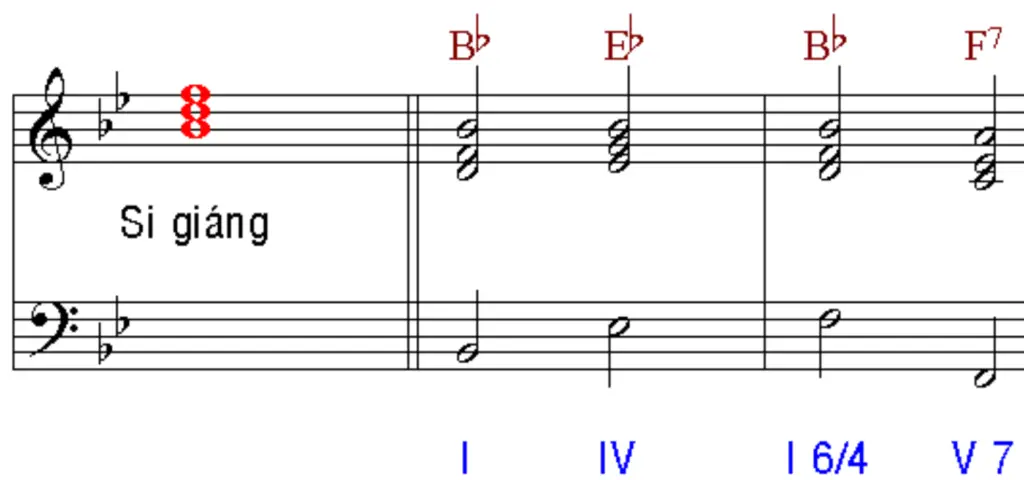When playing the B-Flat major scale in the treble clef, you’ll notice how smoothly the notes flow both ascending and descending. This scale is great for beginners because it follows a clear pattern, making it easy to recognize in sheet music. The presence of Bb and Eb gives it a warm, mellow tone, making it a favorite among musicians who enjoy expressive melodies.
I remember when I first learned this scale, it felt a bit tricky due to the flat notes, but with practice, it became second nature. If you focus on the hand positioning and listen closely to the tonal quality, you’ll get comfortable with the B-Flat major scale quickly.
B-Flat Major in the Bass Clef

For those playing lower-pitched instruments, the B-Flat major scale in the bass clef is a fundamental part of learning harmony. This scale runs ascending and descending just like in the treble clef, but the notes sit lower on the staff, creating a rich and deep resonance. Mastering this in the bass clef helps musicians build a strong foundation in music theory.
I’ve often used this scale as a warm-up before playing more complex pieces. It helps develop finger strength and ear training. Whether you’re on a piano, a double bass, or even a tuba, understanding the B-Flat major scale in the bass clef allows for smoother transitions when playing in different keys.
B-Flat Major Scale Formula
Every major scale follows a specific formula of whole and half steps, and the B-Flat major is no different. The pattern goes Whole step, whole step, half step, whole step, whole step, whole step, half step—or in short, W W H W W W H. If you’re used to British terminology, you might recognize it as Tone, tone, semitone, tone, tone, tone, semitone, which is written as T T S T T T S.
When I was learning scales, understanding this formula made transposing music much easier. Once you get comfortable with the whole and half steps, you can apply the same pattern to any major scale and unlock a deeper level of music theory.
B-Flat Major Scale Degrees and Technical Names
In music theory, every note in a scale has a specific role, referred to as degrees and technical names. The 1st degree is called the Tonic (Bb), followed by Supertonic (C), Mediant (D), Subdominant (Eb), Dominant (F), Submediant (G), and finally, the Leading tone (A). Recognizing these names helps musicians understand chord progressions and melodic movement.
For example, the Dominant (F) is crucial because it creates tension that resolves back to the Tonic (Bb). Learning these technical names helped me analyze music more effectively, making compositions and improvisations feel more intentional rather than random.
B-Flat Major Key Signature
To simplify sheet music, musicians use a key signature instead of writing accidentals every time a flat or sharp appears. The B-Flat major key signature consists of Bb and Eb, which are found in all treble, alto, tenor, and bass clefs. This means whenever you see this key signature, you automatically play those notes as flats unless marked otherwise.
Once I became familiar with this key signature, reading music became much easier. Instead of second-guessing every flat, I could focus more on expression and dynamics. Whether you’re playing a wind instrument or piano, recognizing the B-Flat major key signature is essential for smooth and accurate performances.
What is the Relative Minor of B-Flat Major?
Every major key has a relative minor, and for B-Flat major, it’s G Minor. The reason they are connected is that they share the same key signature, meaning they both contain Bb and Eb. If you play the G natural minor scale, you’ll notice it has the same notes but starts on G, making it feel more somber compared to B-Flat major.
A quick way to find any relative minor is to count three semitones down from the major key. Starting at Bb, move to A, then Ab, and finally G. This trick helped me understand how major and minor keys relate, making it easier to switch between moods in music.
Adam Smith is the Founder, writer, and news publisher of GetMuzeek, where he shares the latest updates, insights, and stories from the world of music. With a passion for uncovering fresh trends and delivering engaging content, Adam keeps readers informed and inspired.